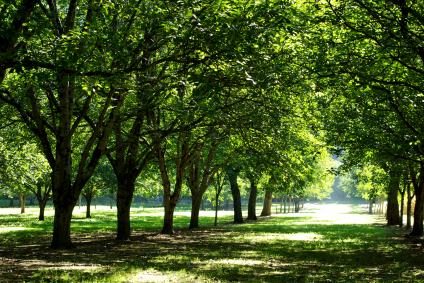A gallery focusing on the leaves from different native Irish trees

[cs_section id=”” class=” ” style=”margin: 0px; padding: 45px 0px; ” visibility=”” parallax=”false”][cs_row id=”” class=” ” style=”margin: 0px auto; padding: 0px; ” visibility=”” inner_container=”true” marginless_columns=”false” bg_color=””][cs_column id=”” class=”” style=”padding: 0px; ” bg_color=”” fade=”false” fade_animation=”in” fade_animation_offset=”45px” fade_duration=”750″ type=”1/1″][cs_text id=”” class=”” style=”” text_align=””]Considering that it is Tree Week (6th to the 13th of March) and to coincide with our gallery of Native Irish Trees we have released a gallery of leaves found on native Irish trees. Tree Week raises awareness about the important ecosystem service trees provide.[/cs_text][/cs_column][/cs_row][/cs_section][cs_section id=”” class=” ” style=”margin: 0px; padding: 45px 0px; ” visibility=”” parallax=”false”][cs_row id=”” class=” ” style=”margin: 0px auto; padding: 0px; ” visibility=”” inner_container=”true” marginless_columns=”false” bg_color=””][cs_column id=”” class=”” style=”padding: 0px; ” bg_color=”” fade=”false” fade_animation=”in” fade_animation_offset=”45px” fade_duration=”750″ type=”1/1″][x_slider animation=”slide” slide_time=”7000″ slide_speed=”1000″ slideshow=”false” random=”false” control_nav=”false” prev_next_nav=”true” no_container=”false” ][x_slide]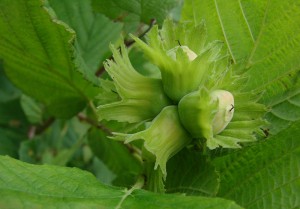
Hazel / Corylus avellana / Coll: Hazels have simple, rounded leaves with double-serrate margins. The flowers are produced very early in spring before the leaves, and are monoecious, with single-sex catkins, the male catkins are pale yellow and 5–12 cm long, and the female ones are very small and largely concealed in the buds, with only the bright-red, 1-to-3 mm-long styles visible. The fruits are nuts 1–2.5 cm long and 1–2 cm diameter, surrounded by an involucre (husk) which partly to fully encloses the nut.[/x_slide][x_slide]
Ash / Fraxinus excelsior / Fuinseog: The leaves of this tree are opposite (rarely in whorls of three), and mostly pinnately compound, simple in a few species. The seeds, popularly known as “keys” or “helicopter seeds”, are a type of fruit known as a samara. Most Fraxinusspecies are dioecious, having male and female flowers on separate plants; if grown as an ornamental and both sexes are present, ashes can cause a considerable litter problem with their seeds. Rownas or mountain ashes have leaves and buds superficially similar to those of true ashes but belong to the unrelated genus Sorbus in the rose family.[/x_slide][x_slide]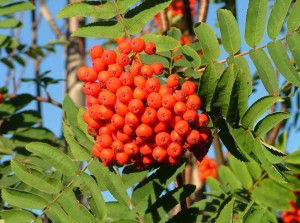
Rowan / Sorbus aucuparia / Caorthann: Rowan leaves are compound and pinnate in form, meaning that each leaf is made up of matched pairs of leaflets on either side of a stem or rachis, with a terminal leaflet at the end. Leaves are up to 20 cm. in length, and are comprised of 9-15 leaflets, which are serrated with small teeth. Rowan is a deciduous tree, with the new leaves appearing in April, and they turn a bright orange-red colour in autumn before being shed.[/x_slide][x_slide]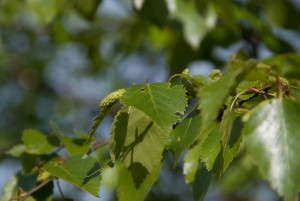
Birch / Betula pendula / Beith gheal: Birch has green leaves that are oval or elliptical in shape. Leaves are single or double serrated on the edges. They often appear in pairs, but these pairs are really borne on spur-like, two-leaved, lateral branchlets. Individual flowers are arranged in long clusters known as catkins. They hang from the branches during the summer. Birch tree produces fruit called “samara” which can release around 1 million seeds each year.[/x_slide][x_slide]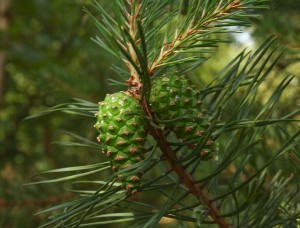
Scots pine / Pinus sylvestris / Péine albanach: The shoots of the scots pine’s leaves grow in a spiral, or circular, pattern flat against the stem. They look just like the scales of a small reptile, but when they grow into full leaves they appear as silver-green needles. The yellow flowers are the male and the red flowers are the female, and both colour flowers grow on the same tree. It is the red female flowers that eventually form the cone, making a protective shell for the seeds.[/x_slide][x_slide]
Willow / Salix species / Saileach: The leaves are typically elongated, but may also be round to oval, frequently with serrated edges. The leaves are simple, feather-veined, and typically linear-lanceolate. Usually they are serrate, rounded at base, acute or acuminate. The leaf petioles are short, the stipules often very conspicuous, resembling tiny, round leaves, and sometimes remaining for half the summer. On some species, however, they are small, inconspicuous, and caducous (soon falling). In color, the leaves show a great variety of greens, ranging from yellowish to bluish.[/x_slide][x_slide] Pedunculate oak / Quercus robur / Dar ghallda: Leaves are alternate, oblong with four to five rounded side lobes; the lobes at the base of the leaf (auricles) are also rounded. Leaf stalks are short (up to 5mm). Pedunculate oak is monoecious: both male and female flowers are found on the same tree. Both appear with the leaves in spring. Seeds are acorns in a scaly, woody cup – one, two or three together on one long common stalk or ‘peduncle’. Oak is wind pollinated. Spring leaves are often hastily eaten by insects hence a second flush is produced in summer traditionally termed ‘Lammas’ growth as it often coincided with the Lammas wheat harvest festival on 1 August.[/x_slide][x_slide]
Pedunculate oak / Quercus robur / Dar ghallda: Leaves are alternate, oblong with four to five rounded side lobes; the lobes at the base of the leaf (auricles) are also rounded. Leaf stalks are short (up to 5mm). Pedunculate oak is monoecious: both male and female flowers are found on the same tree. Both appear with the leaves in spring. Seeds are acorns in a scaly, woody cup – one, two or three together on one long common stalk or ‘peduncle’. Oak is wind pollinated. Spring leaves are often hastily eaten by insects hence a second flush is produced in summer traditionally termed ‘Lammas’ growth as it often coincided with the Lammas wheat harvest festival on 1 August.[/x_slide][x_slide]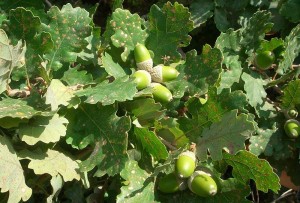
Sessile oak / Quercus petraea / Dair ghaelach: The leaves are 7–14 cm (2.8–5.5 in) long and 4–8 cm (1.6–3.1 in) broad, evenly lobed with five to six lobes on each side, and a 1-centimetre-long (0.39 in) petiole. The flowers are catkins, produced in the spring. The fruit is an acorns 2–3 cm (0.79–1.18 in) long and 1–2 cm (0.39–0.79 in) broad, which matures in about six months.[/x_slide][x_slide]
Holly / Ilex aquifolium / Cuileann: Plants in this genus have simple, alternate glossy leaves, typically with a spiny toothed, or serrated leaf margin. The inconspicuous flower is greenish white, with four petals. They are generally dioecious, with male and female flowers on different plants. The small fruits of Ilex, although often referred to as berries, are technically drupes. They range in color from red to brown to black, and rarely green or yellow. The “bones” contain up to ten seeds each. Some species produce fruits parthenogenetically, such as the cultivar ‘Nellie R. Stevens’. The fruits ripen in winter and thus provide winter colour contrast between the bright red of the fruits and the glossy green evergreen leaves. Hence the cut branches, especially of I. aquifolium, are widely used in Christmas decoration.[/x_slide][/x_slider][/cs_column][/cs_row][/cs_section]

